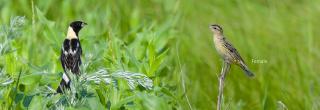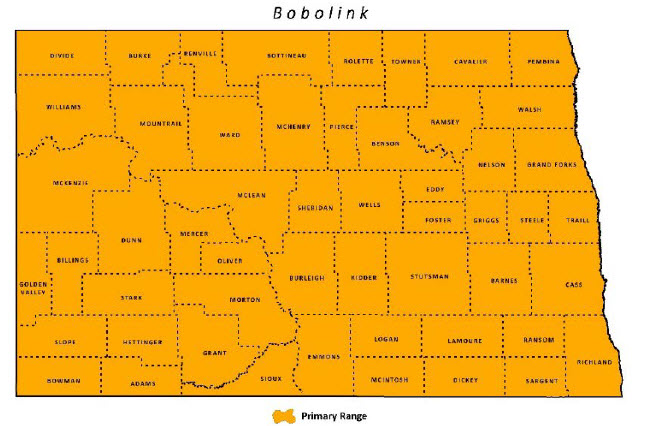
Bobolink
| Scientific Name | Dolichonyx oryzivorus |
|---|---|
| General Description | L 7”, WS 11.5”, 1.5 oz. Males sport a black belly, white rump and back, white patch on wings, and yellow hind neck. The female is yellowish-buff overall. |
| Status | Occurs in North Dakota from May to mid-September. Peak breeding season early June to mid-July. |
| Abundance | Fairly common to abundant. |
| Primary Habitat | Tall and mixed-grass prairie, hayland, and planted grassland. |
| Federal Status | Migratory Bird. |
| Reason for Designation | The Bobolink is experiencing a range-wide decline, although apparently increasing or stable in North Dakota. However, loss of grassland and CRP may cause populations to decline. Partners in Flight (PIF) identifies the Bobolink as a Regional Concern and Stewardship Species, U.S.-Canada Concern and Stewardship Species, and a Common Bird in Steep Decline. |
Locations and Conditions of Key Habitat
Preferred Habitat
Bobolinks use areas of moderate to tall and dense vegetation, and moderately deep litter. Native and tame grasslands, hayland, light to moderately grazed pasture, no-till cropland, small-grain fields, old fields, wet meadows, CRP, and DNC habitats are used. In mixedgrass pastures, are positively correlated with percent grass cover, litter depth, density of low-growing shrubs such as snowberry, vegetation density, plant communities dominated by Kentucky bluegrass and native grass. Abundance is negatively correlated with percent clubmoss, bare ground, and communities dominated solely by native grass. Typically avoid areas with woody vegetation. Peak abundance of Bobolinks in a grassland is within 1-3 years post-burn, but decreases after 5 years post-burn. Will not use heavily grazed pastures, but high densities have been found in areas under shortduration grazing versus completely idle areas. May be area sensitive, requiring a minimum of 10-30 ha of prairie. Nest on the ground almost always beneath a large forb. Forages on a variety of seeds and insects.
Key Areas and Conditions for bobolink in North Dakota
No specific sites have been identified.
Problems Which May Affect this Species
Habitat
Conversion of grassland to cropland, energy development and urban expansion. Degradation of grasslands from invasive plants, woody encroachment, succession, and loss of diversity. CRP provides important breeding habitat and is likely the reason for an increase in Bobolinks in North Dakota since the mid-1990s. It has been predicted if all CRP in North Dakota were converted back to cropland, the number of Bobolinks would be reduced by about 10%. Occurrence declines with increasing tall shrub cover and woodland cover. Open, treeless grasslands are required for maximum probability of occurrence.
Other Natural or Manmade Factors
Nests are occasionally parasitized by brown-headed cowbirds and nest predation is fairly high. Bobolinks may be killed on their wintering grounds where it is considered an agricultural pest. Mortality from collisions with communication towers. Grassland birds avoid habitat within 150 meters of roads and 350 meters of oilfield infrastructure, likely due to anthropogenic disturbance of heavy traffic and/or changes in habitat near oil development.
Research and Survey Efforts
Current Research or Surveys
- Southern Illinois University (ND SWG T-43-R) is studying abundance, productivity and nest survival of grassland nesting birds in different vegetation types. A final report is anticipated in 2016.
Previous Research or Surveys
- University of Montana (ND SWG T-1-R) developed breeding bird models which link population density to local and landscape habitat features in the Prairie Pothole Region of North Dakota. Bobolink was one of 16 grassland bird focal species. The project was initiated in 2002, a final report was provided in 2004 (Naugle 2005), and dissertation in 2007 (Quamen 2007). Further analysis of the data was recently analyzed on 5 study species (Doherty et al. in press). Bobolinks showed avoidance of cropland or selection for grassland at both the landscape and local scales, had higher abundances in exotic grass, and showed positive relationship to visual obstruction.
- Numerous published reports and gray literature on this species throughout its range.
Additional Research or Surveys Needed
Nothing specific at this time.
Population and Trend Estimates

- PIF Global Population Estimate: 8,000,000
- PIF North American Population Estimate: 8,000,000
- PIF North Dakota Population Estimate: 1,800,00
- North Dakota BBS Trend: see figure 9
- Survey-wide BBS Trend 1966-2012: -2.17
Management Recommendations
- Protect large tracts of grassland, particularly native prairie.
- Prevent encroachment of woody vegetation in grasslands.
- Burn grassland every 2-4 years to prevent encroachment of woody vegetation and remove deep litter.
- Encourage vegetative diversity.
- Delay mowing until July 15.
- Provide hayland areas and mow as late as possible. High densities of Bobolinks have been found using hayland mowed the previous year.
- Use native grasses when replanting or restoring grassland.
- Construction of communication towers should follow the guidance of “Service Interim Guidelines for Recommendations on Communications Tower Siting, Construction, Operation, and Decommissioning” and American Bird Conservancy Collision Program framework.
Monitoring Plans
According to the Partners in Flight Landbird Conservation Plan, long-term population trend monitoring such as the Breeding Bird Survey is generally considered adequate, but may not account for some issues (e.g. bias). Ensuring all BBS routes are conducted annually is priority. Future monitoring proposals should follow recommendations North American Bird Conservation Initiative ‘Opportunities for Improving Avian Monitoring’.
2005-2015 Progress
The Bobolink remains a Level II Species of Conservation Priority. Several State Wildlife Grant Projects (T2-11-HM, T-18-R, T-20-D, T-21-D, T-22-HM, T-23-HM, T-25-HM, T-28-L, T-37-D)) have contributed to habitat enhancement grasslands for Bobolink and other grassland dependent birds.

Note: A listing of works consulted when compiling the information on this page may be found in the 2015 State Wildlife Action Plan.
